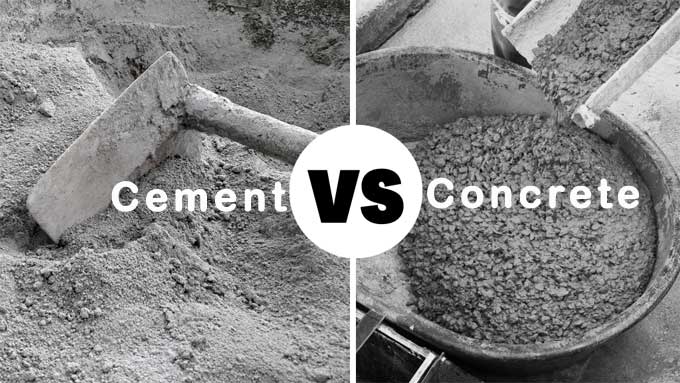
Building Materials: Concrete or Cement

What do you mean by Concrete?
Cement, aggregate, and water combine to form the composite material known as concrete. It may be a strong and long-lasting building material that is utilised in a variety of applications to build foundations, walls, and floors.
When making concrete, the aggregate such as stones or gravel and the water are held together by the cement, which serves as an adhesive. A solid substance that is highly durable and will endure for years with proper maintenance and care is created when the cement sets, hardens, and solidifies, forming a strong link between the components.
What do you mean by Cement?
Limestone and clay are calcined to produce cement, a powdery material. Concrete is hardened and strengthened by this compound, which is used as a binder in construction. Cement mixes in some areas may contain trace quantities of shale, fly ash, gypsum, iron oxide, ore, or iron.
Because it contains iron or manganese, Portland cement has a typical grey tint. The same components are used to make white portland cement, which does not contain iron or manganese.
What are the differences between Concrete and Cement?
Cement is an ingredient of concrete, though the terms cement and concrete are often used interchangeably. Mixing aggregates with paste is the basis of concrete. Crushed stone or sand and gravel are used as aggregates, and Portland cement and water are used as a paste.
Concrete mixes contain between 10 and 15 per cent cement by volume. When cement is mixed with water, it hardens and binds the aggregates into a rock-like mass. In addition to hardening, concrete becomes stronger over time.
Like stainless steel and sterling silver, Portland cement is not a brand name, but a generic term for the type of cement used in virtually all concrete. In other words, there is no such thing as a cement sidewalk or a cement mixer; instead, they are referred to as concrete sidewalks and concrete mixers.
What are some merits of Cement?
There are a number of advantages to cement, including its affordability, durability, and versatility. Cement is one of the most widely used building materials in the world because of its low cost and ease of availability. In addition to being extremely strong and durable, it is also ideal for building large structures that last a long time. The versatility of cement allows it to be used in a wide variety of applications, including floors, walls, and roofs.
Furthermore, cement is very resilient to weathering and severe temperatures. It is a fantastic option for places with significant levels of precipitation or winter temperatures that dip below freezing because of its resilience to water and frost. Cement is a great material for fire-resistant walls and foundations because of its tremendous fire resistance.
The cement can also be painted and dyed easily, making it an excellent choice for creating attractive designs and colours. A cement structure can be customized and made to look unique and aesthetically pleasing with the right techniques.
What are some merits of Concrete?
The strength of concrete makes it perfect for handling heavy rains, extreme temperatures, and high winds. The material is also corrosion-resistant, making it a great material for building foundations and other outdoor structures.
The cost of using concrete is typically less than that of cement, making it a very affordable building material. Builders who are cost-conscious will find it an excellent choice.
Concrete is the ideal building material for every project, from foundations and walls to driveways and patios, because of its strength and durability. Concrete may be shaped into many different forms and sizes, enabling original layouts and patterns.
One of the most environmentally friendly building materials is concrete. It is largely recyclable and made of natural resources including sand, gravel, and water. Additionally, it uses less energy, making it a great option for environmentally friendly building projects.
Which material should you use Concrete or Cement?
Depending on the type of construction project, the choice of material will vary. If you need to construct a grout type material for small areas then you should prefer cement, otherwise for bigger projects concrete is preferred.
What is the working mechanism of Concrete and Cement?
Concrete
Aggregates are mixed with coarse and fine particles. In order to fill in the spaces left by coarse aggregates, fine aggregates are used. These aggregates are bound together with cement or asphalt. To obtain strength, the coarse and fine particles must be graded properly. One of the crucial components of concrete is the water-to-cement ratio. Concrete becomes more durable over time.
To learn more, watch the following video tutorial.
Video Source: civilogy
Cement
A hydration process takes place when cement and water are combined, forming a hardened cement paste.
There are two responses that happen during hydration. The cement sets as a result of the first reaction. The cement then hardens as a result of the second reaction, forming tobomite gel. Tobomite gel served as the principal adhesive between the aggregates.


